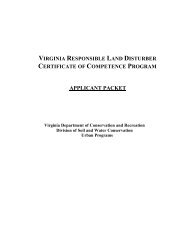Dameron Marsh NAP self-guided field trip guide - Virginia ...
Dameron Marsh NAP self-guided field trip guide - Virginia ...
Dameron Marsh NAP self-guided field trip guide - Virginia ...
Create successful ePaper yourself
Turn your PDF publications into a flip-book with our unique Google optimized e-Paper software.
Onto the boardwalk...<br />
• Once you reach the end of the boardwalk...everything in front of you is the salt marsh community,<br />
regularly flooded by salt water. Salt marshes are the most productive ecosystems on earth, producing<br />
more organic material per acre per year than tropical rain forests or modern agriculture. They<br />
have very low diversity (number of species) compared to fresh water marshes.<br />
• Salt marshes perform many important functions. They provide important habitat for many organisms,<br />
especially juvenile marine organisms. They are an important food source. Few organisms actually<br />
eat the grasses. Instead, the debris is decomposed by microbes and the slimy particles<br />
(detritus) form the food. <strong>Marsh</strong>es trap sediment and the dense root (rhizome) network retards erosion.<br />
Nitrate in groundwater discharging into the marsh is converted to nitrogen gas so that it does<br />
not fertilize the marine water.<br />
• All salt marsh plants require full sunlight for best growth. People whose property includes marshes<br />
should prune back all overhanging vegetation and remove trash (and Phragmites) to provide the<br />
marsh with full sunlight.<br />
• The seaward-most grass, common cordgrass (Spartina alterniflora) extends down to mid-tide level<br />
(low marsh). Marine grasses do not grow below mid-tide level. Although submerged grasses (SAV<br />
or Submerged Aquatic Vegetation) were once abundant around the Preserve (see the 1937 air<br />
photo), about 90% of the area they once occupied is now barren.<br />
• Between the common cordgrass and the observation deck, in areas periodically flooded by high<br />
spring tides (high marsh), the common plants are:<br />
Black Needle-Rush (Juncus roemerianus) - note the black-tipped round stems.<br />
Salt Grass (Distichlis spicata) - sometimes you can see salt crystals on the leaves.<br />
Three-Square (Scirpus robustus) - look for triangular stems and spiky seed pods. This genus is<br />
especially important for wildlife, including ducks.<br />
Common Reed (Phragmites) - unfortunately.<br />
• The loblolly pine community, seen in the distance, occupies the highest ground. Three of the four major<br />
communities in the Preserve can be seen from the observation deck, the marine salt marsh, the <strong>field</strong><br />
succession and the loblolly pine communities.
















